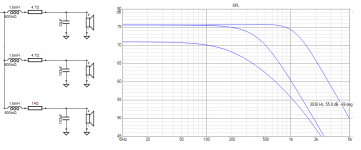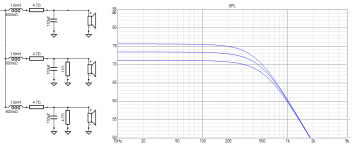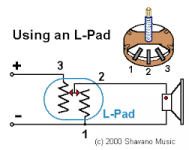Was I wrong. My problem doesn't exist. I played the CD on my two other systems and it sounds exactly the same on all three. Seems this recording, and especially the first track, accents stick clicking/tapping sound on cymbals above the cymbal sound in the left and accents the cymbal sound above the stick tapping sound in the right. I haven't heard such a pronounced difference before. Going forward, when I think there is a problem, I will make it standard practice to use all three systems to aid diagnosis. Sorry for all the unecessary posts.
So I added a 2.2cap and sound seemed a bit better. Next day I added a 1.0cap. Two day later I added a 0.47. Three days later I added a 0.22cap. Now after listening for a week the details in Matko Joanna by Tomasz Stanko are incredible.
This is an update on the mid range filter and a question. I've added more caps and now the mid range filter has 153uF. The upper piano notes are still a bit too predominate so I increased the resistor value from 5oHms to 14oHms and it was an improvement. But the upper piano notes are still a bit too predominate. My question is, instead of adding more caps would increasing the resistor value be a good option? That would be much less costly than buying more caps.
I don't have equipment to do that. I use my ears. I've built other XOs that sounded good to me. Bottom line is would increasing resistor value instead of increasing cap uF value be reasonable?
Thanks Allen. The mid XO point is supposed to be 3000Hz. So if I understand your plot, the two curves using 153uF should have significant drop off (lower volume at higher frequencies) than the22uF curve. Is that correct?
That's right.
Sometimes when you cut too far, for example leaving the tweeter more exposed near its cross then it can stand out. I'm just thinking out loud here.. If it has a smooth rolloff then it's necessary to get the next driver in underneath it to support it in frequency. Crossover blending can be challenging to get right sometimes.
Sometimes when you cut too far, for example leaving the tweeter more exposed near its cross then it can stand out. I'm just thinking out loud here.. If it has a smooth rolloff then it's necessary to get the next driver in underneath it to support it in frequency. Crossover blending can be challenging to get right sometimes.
The high piano notes are coming from the mid range. I verified this by disconnecting the tweeter and all the upper piano notes came from the mid range. I also reconnected the tweeter and disconnected the mid range and there were no piano notes.
Ok. As the plot suggests you can adjust level with the resistor, but maybe you need to change the capacitors at the same time.
Also, an L-pad (in other words a resistor across the driver) could help if you get a lower peak due to the impedance. I can't remember, was there an impedance plot you were using in simulations?
Also, an L-pad (in other words a resistor across the driver) could help if you get a lower peak due to the impedance. I can't remember, was there an impedance plot you were using in simulations?
No impedance plot but I had looked into using an L-pad. I will try that tonight. And I've been doing all changes on the right channel XO. The left channel XO as it has been with the 22uF caps. I will try the L-pad there.
Better to leave the 4.7 ohm resistor before the capacitor. If you change it to after the capacitor you will probably introduce a peak in the response. (It could be done the other way but it needs care and perhaps that means simulation..)
So you can still add a resistor across the driver like the crossover is now, and it will still bring the levels down, and it will protect from low impedance while helping with the resonance peak.
So you can still add a resistor across the driver like the crossover is now, and it will still bring the levels down, and it will protect from low impedance while helping with the resonance peak.
I was planning to leave the series resistor where it is. I believe in only making one change at a time. All the resistors are connected with wire nuts so I will take one from the right XO.
Ok, it's just that we were talking about L-pads and I didn't know how you would see that.I was planning to leave series resistor where it is. I believe only one change at a time is the way to go.
I found a few L-pad calculators and the formula on the web. I tried three and they all came up with the same results. I'm using Erse's calculator. Love those alligator clips.
I was amazed at the effect of adding an resistor across the driver. I started with a 2.2ohm and the upper piano not'es volume was reduced. Next I replaced it with a 1.5omh resistor and there was more reduction. Next I replaced it with a 1.0ohm and the reduction was getting close to what I like. Next I replaced it with a 0.68 and it was just about right. Next I tried a 0.47 ohm and the upper piano notes got much louder. So I'm sticking with the 0.68ohm resistor. But why would the 0.47 have made the upper notes louder than the 2.2ohm resistor? The series resistor is 5.0 ohms. Would reducing that increase or decrease the upper notes volume?
Last edited:
What you do is not the way it should be done. Putting smaller and smaller resistance across the speaker is basically shunting an audio signal to ground.
But you are presenting lower and lower impedance to the amplifier. Not only this leads to higher distortion, but at higher power may damage amplifier.
If you want to attenuate some band after crossover going into speaker, use proper l-pad. It reduces the volume, but maintains constant impedance for amplifier.
See pic.
And btw what you describe 0.47 being louder than 2.2 ohm is nonsense.
But you are presenting lower and lower impedance to the amplifier. Not only this leads to higher distortion, but at higher power may damage amplifier.
If you want to attenuate some band after crossover going into speaker, use proper l-pad. It reduces the volume, but maintains constant impedance for amplifier.
See pic.
And btw what you describe 0.47 being louder than 2.2 ohm is nonsense.
Attachments
I don't know what the cause is but it's possible that the treble becomes dominant as the midrange goes below that level.
We discussed keeping the series resistor in place. As long as it is there it should allow experimentation.presenting lower and lower impedance to the amplifier.
- Home
- Loudspeakers
- Multi-Way
- Three way crossover question


